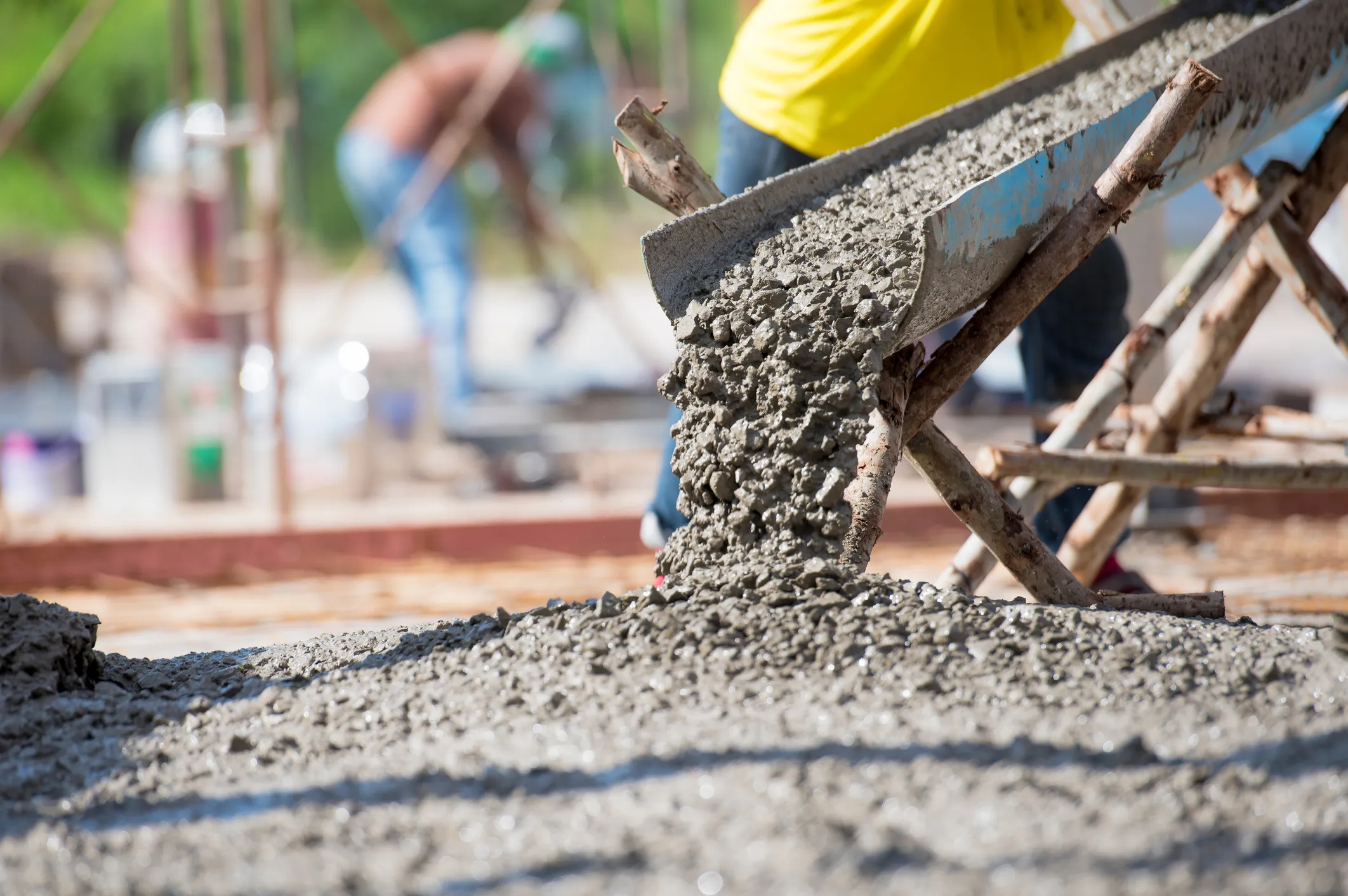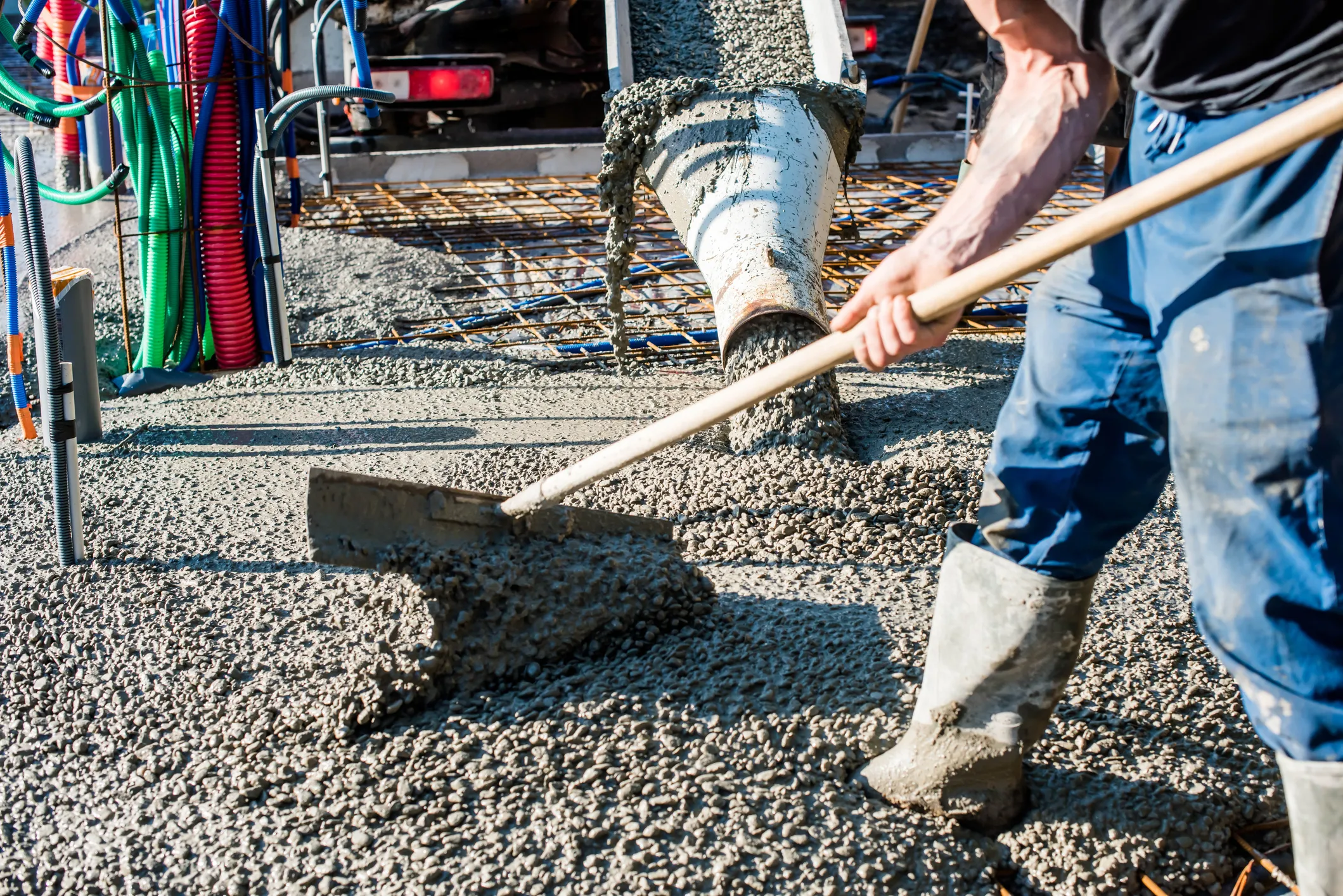A New York construction accident lawyer can explain your legal options and guide you through the claims process. Contact The Weinstein Law Group today at (212) 741-3800 for a free consultation.

What’s the difference between cement and concrete?
Many people use “concrete” and “cement” interchangeably, but in fact, cement is an ingredient in concrete. Concrete consists of aggregates (crushed stone or gravel and sand) and paste, composed of Portland cement (about 15% of the mixture) and water.
So, there isn’t such a thing as a cement sidewalk or cement mixer, but more properly, a concrete sidewalk and concrete mixer. However, this distinction may not matter much to a NYC construction worker injured from a concrete burn.
Concrete comes in three forms, powder, liquid, and solid, and is dangerous in each form. Exposure to wet concrete or concrete powder can result in anything from mild eye, skin, or lung irritation to severe third-degree burns.
What should I do if I come in contact with wet cement on the job?
Fast treatment after your skin comes in contact with wet cement is critical to reducing the damage to your dermis.
Follow these steps if wet concrete touches your skin:
- Immediately rinse the affected area with clean, cool water. In fact, wash all exposed skin (anything not covered by your protective clothing and gear) to ensure you haven’t missed any spots.
- Change your clothing and protective gear if it has wet concrete on it.
- Monitor your skin for the next 24 hours, as concrete burns may take hours to develop.
If your skin is exposed to wet cement or you suffer a cement burn:
- Immediately wash all exposed skin with cool, clear water.
- Apply vinegar to the affected area. Cement is alkaline, while vinegar is basic. Therefore, the vinegar will neutralize the acid and help reduce the severity of the dermal damage.
Because concrete burns can take several hours to show up, it’s vital to get medical attention right away, even if your skin doesn’t look damaged. Early intervention may help stop the spread of the chemicals and reduce the damage to the deeper layers of the dermis and the muscle below.
Your injury may likely be eligible for workers’ compensation insurance coverage, so you should report the injury to your employer right away. If it’s severe enough that you need to go directly to the ER, then report the injury as soon as your condition is stabilized.
Why does cement burn skin?
Concrete and cement are caustic, which means they can corrode organic tissue like your skin, subcutaneous fat, and muscle, leading to anything from a rash-like irritation to thickened, cracked skin or necrosis. It’s not pretty. If the substance remains on your skin, the chemicals in the concrete burn deeper and deeper.
The chemical makeup of concrete is what makes it so highly corrosive. Specifically, the presence of Portland Cement, the binder ingredient making up about 15% of concrete’s composition.
Let’s get a little technical about specifically why cement is so dangerous and what is concrete burn.
Uncured, wet Portland cement can reach a pH level of up to 12, on the very high end of the basic side of the pH scale. The pH scale ranges from 0-14, with 0 being the most corrosive acid and 14 the most corrosive base. Water is usually neutral, around a 7. pH measures the strength of an acid or base; as a 12 pH, Portland cement is chemically basic and very corrosive.
Your skin is about 4.7 pH, so somewhat acidic. When cement comes into contact with the skin, the chemical reaction causes the skin to corrode. Chemical burns look much like burns from a fire, with blistering and weeping sores, and because they can cause just as must damage to the skin as fire or electrical burns, chemical burns carry a similarly high infection risk.
The dangers of wet cement on construction sites
Continuous contact between wet concrete and your skin causes chemical burns. Even if you’re wearing thick pants, a long-sleeved shirt, and a good pair of work gloves, you could still suffer chemical burns if your clothing gets soaked with wet concrete. Concrete burn injuries are preventable, though, with the right protective gear and safety protocols at the job site.
By the time you notice, damage has likely already occurred
Unfortunately, by the time you become aware of a concrete skin burn, the damage may have irrevocably progressed. Chemical burns can cause a stinging or tingling sensation, but usually not immediately, unlike the immediate burning sensation from fire.
Often, by the time you feel the chemical burn, a lot of damage has already happened, and the chemicals will continue to penetrate the layers of the dermis to the muscle underneath. Worst case scenario, the chemical reaches the bone.
Skin conditions
Allergic skin actions are common, even for just a brief exposure to concrete or cement, due to the presence of hexavalent chromium, a chemical in cement. Hexavalent chromium is toxic, and chronic exposure or overexposure can cause a whole host of nasty health issues, from liver damage to skin lesions and ulcers and respiratory problems like wheezing and shortness of breath.
Concrete burns, in general, cause serious problems, depending on the breadth and depth of the affected area. Redness and itching, swelling, and blisters are common for mild concrete chemical burns, while more severe burns could cause large, fluid-filled blisters and cracked, scaling, black, or green skin.
If the concrete (wet or dry powder) isn’t washed off the skin immediately, it starts hardening, absorbing moisture from the skin. The hardened concrete causes the blistering and corrosion associated with chemical burns. Victims could start bleeding, and the affected limbs or skin could start swelling.
Dry cement can be dangerous, too
Dry cement poses less of a chemical burn risk than wet cement, but it’s still dangerous, especially when you’re dumping out a bag of dry concrete mix or cutting concrete. The biggest danger it poses is when the dry dust comes into contact with moisture on your body, like in your lungs, on sweaty skin, or even your eyes.
The dust mixes with the moisture and forms a corroding compound that starts burning the affected tissue.
When working with dry concrete or concrete dust, it’s important to be in a well-ventilated area and wear protective gear like goggles and a mask.
Employers must provide protection against construction burns
New York construction employers are required to provide workers with safe working conditions, including the right personal protective equipment (PPE) and safety gear and the right sort of ventilation to prevent harm caused by inhaling dangerous chemicals like concrete or cement dust.
Respiratory gear
The U.S. Occupational Safety and Health Administration (OSHA) sets a permissible exposure limit (PEL) of dry Portland cement: 15 mg/m3 of air for the total dust and 5 mg/m3 for respirable dust. If the job site is not ventilated enough to reach the OSHA standard, the employer must provide workers with proper respiratory protective gear, like a P, R, or N-95 respirator.
Hand and eye protection
Other PPE concrete and cement construction workers should use include eye protection, sturdy boots, thick gloves, and durable clothing. These should be the minimum standard for any work involving wet cement.
So much of concrete and cement work is hands-on, so the right kind of gloves are essential:
- Made from nitrile or butyl, not leather or cotton
- Well-fitting, snug around the hands and fingers to prevent concrete from getting inside
- Alkali-resistant (resistant to basic chemicals like those found in concrete)
Make sure to thoroughly wash and dry your hands before donning concrete-working gloves. Rinse the gloves thoroughly with cool, clear water when finished working, and then thoroughly wash your hands after removing the gloves.
Don’t wear contacts when working with cement or concrete, whether wet or dry and use safety goggles with side shields. These should be snug around the face and wiped down after use.
Your employer should also provide an adequate washing-up station, per OSHA Standard 1926.51(f)(1), and have it close enough to the work site so that you can easily reach it in an emergency.
If your employer fails to provide adequate safety gear and a cleaning station, contact a New York cement burn injury attorney.
What’s recovery like for concrete burn victims?
Chemical burns from cement and concrete cause serious physical damage. Victims face weeks or months of painful recovery, and many are permanently disfigured. Always get medical attention from a professional who knows how to treat a concrete burn.
The consequences of concrete chemical burns are painful and require lengthy, intensive medical treatment. Many people may require skin grafts to replace the decayed skin or have problems moving if the underlying muscle tissue is damaged. Severe scarring and puckering develop as the victims heals. In the most extreme cases, the tissue cannot be fixed, so the victim may have fingers or limbs amputated to remove the necrotic tissue.
Recovery from serious concrete chemical burns is long and painful, and victims may be out of work for weeks recovering. If this happens to you, you may be able to pursue a workers’ compensation claim or even a third-party lawsuit if a third party, like a subcontractor or vendor, caused your injuries.
Do you need help pursuing a concrete burn injury claim? We can help you demand the compensation you deserve.
Chemical burns from concrete can change your life, leaving you unable to return to work or with severe scarring or disfigurement. There’s a good chance you’ll need surgery or skin grafts, and you may be unable to continue in the same line of employment.
Your employer or a third party may be liable for your injuries and responsible for compensating you for your losses. This includes any medical care you need, unearned wages because you missed work, and any rehabilitative treatment you require to regain your range of motion and abilities. You may also be eligible for compensation for your pain and suffering and the effect of any scarring or disfigurement on your quality of life.
You can learn more in a free consultation with a New York cement burn injury attorney from The Weinstein Law Group. Call us today at (212) 741-3800 to get started.


